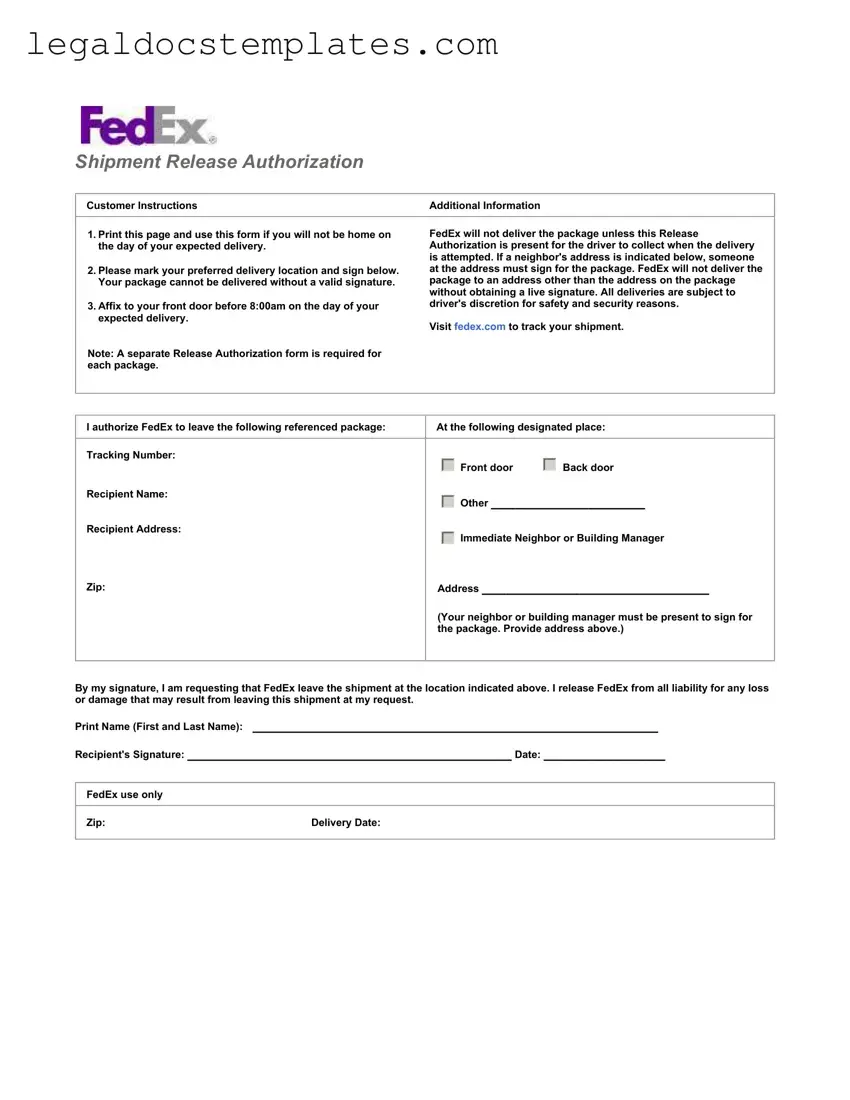The UPS My Choice® Delivery Authorization form closely resembles the FedEx Release form in its functionality and purpose. Like the FedEx form, the UPS version allows customers to specify delivery instructions in advance, including where to leave packages if the recipient is not at home. By signing the form, customers can authorize UPS to leave parcels at a specified location, releasing the carrier from liability for any loss or damage. Both forms are practical solutions for ensuring package delivery when direct receipt is not possible, highlighting a shared focus on customer convenience and flexibility.
A USPS Hold Mail Request form shares a complementary objective with the FedEx Release form but approaches the issue of package handling differently. Instead of authorizing delivery to a specified location, this form requests the postal service to hold all mail for a designated period. The similarity lies in the customization of delivery requirements based on the recipient's availability. Both forms cater to the need for flexibility in how deliveries and mail are managed in the recipient's absence, though they solve the issue through different means.
The DHL Express Shipment Release Authorization is another document mirroring the FedEx Release form. Specific to DHL's delivery services, this authorization allows recipients to pre-approve the leaving of packages without a direct signature. Like its FedEx counterpart, the DHL form requires a signature to validate the delivery instructions, ensuring that the parcel can be left as per the recipient's wishes. This form underscores the global courier industry's commitment to accommodating customer preferences for delivery, irrespective of the courier company.
Apartment Rental Lease Agreement, while fundamentally a contract for housing, shares with the FedEx Release form the concept of authorization and stipulated conditions. In lease agreements, tenants agree to terms set by landlords, similar to how recipients agree to FedEx's terms for leaving a package. The documentation of agreements in both cases creates a legally binding understanding between parties about how property (a package or a rental unit) is to be used or treated.
A Property Release Form used in photography and film is designed to secure permission to use images of property, similar to how the FedEx form secures permission to leave packages. Both forms function as written authorizations that grant specific rights to another party—whether it's the right to leave a package at a location without immediate oversight or the right to publish images of someone's property.
Medical Release Forms, which allow the sharing of patient health information under specified conditions, also parallel the FedEx Release form in that they involve granting permissions for specific actions in the absence of direct supervision. Both types of documents provide a signed understanding that certain activities can proceed under agreed conditions, transferring a degree of responsibility and liability in the process.
A Power of Attorney (POA) document can be seen as a more comprehensive counterpart to the FedEx Release form. Both authorize another party to perform actions on one's behalf, albeit in vastly different contexts. A POA might authorize someone to manage financial or legal matters, while the FedEx form strictly pertains to the delivery of packages. Despite their differences, each document centers on trust and delegation of authority.
An Event Liability Release Waiver, often used when individuals participate in potentially hazardous activities, is founded on a concept similar to that of the FedEx Release form—limiting liability. By signing such waivers, participants acknowledge risks and agree not to hold the organizing parties responsible for any injuries. The FedEx form likewise limits the carrier's liability by obtaining the recipient's consent to leave packages unattended.
Lastly, the Click-Wrap Agreement, common in software installations and online services, where users must agree to terms and conditions before proceeding, shares with the FedEx Release form the essential role of consent. By signing or clicking "I Agree," users or recipients formally accept specified terms, thereby enabling the next steps of a service or delivery. Both documents illustrate the modern necessity of documented agreement for the provision of services and the protection of parties involved.
Trademark License Agreements, which allow entities to use each other's trademarks under specific conditions, echo the essential nature of the FedEx Release form in terms of agreement and liability limitation. Just as the FedEx form facilitates agreement on the delivery process and limits liability, trademark agreements specify usage rights and responsibilities to prevent disputes. Both are critical in establishing clear terms for the exchange or handling of property, whether physical or intellectual.

